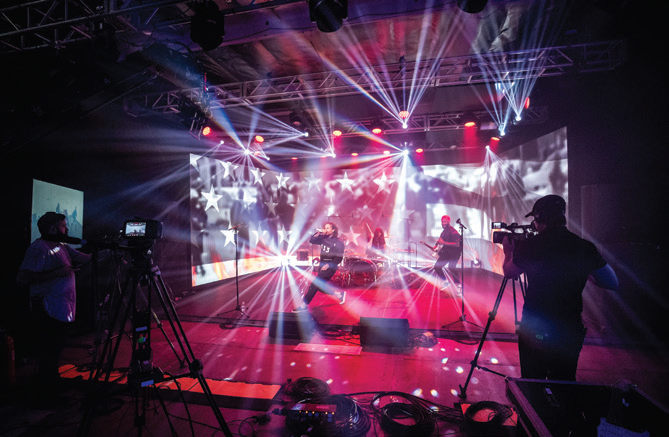Rather than let the pandemic stop their business in its tracks when Covid-19 shut down the live event industry, Spenser Bishop and Kevin Garcia of MixOne Sound pivoted, creating a flexible solution for streaming and filming concerts, music videos and more.
Beyond keeping the business – and their staff – afloat, they reasoned that artists were still going to need a way to connect with their audiences that was more sophisticated than just setting up a web cam at home and that their company, based in Orange County, CA, was uniquely positioned to facilitate that. Bishop (founder and head of audio) and Garcia (MixOne Sound’s video partner and director of film) have worked together closely for four years now,
Bishop explains: “I founded MixOne as a live sound company many years ago, but Kevin and I have intermingled in the video realm, and I always hired him to do my editing, camera work, and things of that nature. Now we’re are branding another division of the company as partners.”
Being a live event production company specializing in all facets of the business (audio, lighting, video, staging and back line), MixOne and Garcia (a touring videographer for bands that include Bush and 311) saw almost a full year of work vanish in the immediate days after the pandemic was declared. “We were ready to go full bore through December and lost everything in one week,” Bishop notes.
When lockdown went into full effect, Garcia was actually working with 311 in Las Vegas at, arguably, one of the last big rock shows mounted pre-pandemic. He explains, “I was filming the concert and we had 7,000 people who’d flown in to be there, and it was like, ‘Do we finish the show or not?’ And Nevada’s governor said, basically, ‘You’ve been here for two days so you might as well finish the job.’ So we did.”
Initially, they hoped the crisis would be short-lived but, as it deepened, they decided to repurpose their facility to meet the needs of the moment. “We’d talked about building a soundstage on site before, but never had enough time,” Garcia notes. “Since we were both here, we put our resources together and went for it.”

Making It Go
They began beta testing in mid-April, filming and recording friends’ bands gratis, and by early May they were good to go. “We were basically building a concert venue in our shop,” Bishop says, “So, between fine-tuning, tweaking, and re-cabling the space, we were about a month into it by the time we were done.”
The first full on use of the space was a live stream featuring rock band FEVER 333, which raised approximately $20,000 for the Minnesota Freedom Fund and Black Lives Matter. “Since then we’ve gotten a lot of calls and emails about the space. It’s pretty exciting and we’re making up some ground here,” Garcia adds.
So far, the bulk of the work has been live streams and/or music videos, but given their combined expertise and the suite of AV technology they have on hand, the possibilities for other applications are huge. “One hundred percent,” Garcia continues. “We actually have a Shark Tank-type TV show that we’ll be doing in the early fall for a major beer brand. Honestly, we’re trying to do whatever we can. And we’re on the way to making money again, which is good, because one of the biggest things on both of our minds is that we have about 12 people who rely on us for work. They do other things, but MixOne is their main freelance income.”
Bishop adds, “I think it also helps keep all of our heads in the right place, To have an outlet, to get back to mixing and keep up my craft has been good for me mentally, and I’m sure it has been for everyone else, too.”
That goes for artists and fans as well. With due respect to the many Zoom, Instagram Live, and virtual gigs and festivals that have been held over the past months, MixOne believes that it’s providing a degree of audio/video quality, excitement and energy for artists and audiences alike that’s difficult to replicate at home. “Artists still want to sound good, look good, and feel like they’re playing actual shows – all together, on stage, with lights hitting them,” Garcia says.
Both Bishop and Garcia started off as musicians, on drums and bass, respectively, but have been laser focused on their specialties in audio and video for many years. Consequently, not only do they bring impressive skill sets to the table for artists working in their space, but a deep knowledge of what artists need – technologically and emotionally – to connect meaningfully with audiences remotely. And the space they’ve carved out at MixOne speaks to that very well – providing a synthesis of a full-on live venue and broadcast studio equipped with flexible, contemporary AV systems manned by accomplished professionals.

Assembling The Package
In all, MixOne’s facilities offer a main stage area, broadcast control and audio record rooms, as well as a dedicated green room that acts as a backstage area, with bathrooms, hang-out space and access to a live feed of the stage. Additional services, i.e., hospitality, a runner, a quick-change area if needed, are also on offer.
The main stage space consists of a 40- by 40-foot production area (with a 28-foot wide by 20-foot stage space) backed by a 48-foot wide by 10-foot high ROE Carbon 3 LED wall and equipped with a lighting rig and ceiling accent panels flown on truss. For video capture, there’s a Blackmagic Design Camera package with an Ursa Mini Pro G2, Ursa Broadcast and Pocket 4k.
For audio, there are two Yamaha CL5 digital consoles, dBTechnologies LVX XM 12 and 15 stage monitors as well as IG3T side fills with S118 subwoofers, and Shure PSM 1000 in-ear personal monitoring and ULX-D digital wireless microphone systems joined by an extensive wired and wireless mic package. “Basically, we’ve got a big festival mic pack with all the major microphones you could think of – Shure, Sennheiser, Telefunken, Warm Audio and Audio Technica – and as many wedges as you could use,” Bishop says.

Meanwhile, the CL5 desks are employed for broadcast, recording, front of house and monitors. “We’ve got two Rio Racks per desk, so we’re fully set up to do multiple ins and outs with a 64-channel split,” he adds. “Then, when we go into my room for re-mixing, we’ve got multiple [Universal; Audio] Satellite Thunderbolt QUAD cores we’re using to re-amp plugins and then bounce them back through the desk, and a ton of UAD, Warm, and Focusrite gear. I’ve also got an Antelope OCX HD master clock on everything and we’re running another computer to bus reverbs and delays in real-time as an aux through the desk. So, instead of using internal effects on the desk I’m passing through a Focusrite interface and using UAD plug-ins in real-time.”
In Bishop’s mix world, monitoring is provided via Genelec 1031A nearfields paired with an ADAM sub and/or Fostex 6301s. “We’re working in Pro Tools and Logic and using Dante, so everything routes to multiple computers for record feeds and to network around the studio,” he adds.
As for video, Garcia explains: “We’re a full-blown Blackmagic Design house, from outboard gear to the cameras themselves. My iMac Pro and Blackmagic Design Atem 1 M/E Production Studio 4k are the brains of all the video stuff. And we set up Vmix on a PC because it’s only PC – that’s how we stream out to the world. Spenser sends me the AES signal, that gets embedded through SDI, hits me, and then goes out to the world.”
The broadcast control room is also equipped with a suite of Blackmagic Design gear, including a custom-built live stream computer system comprised of a Blackmagic Design Atem 1 M/E Production Studio 4k, Hyperdeck Studio Mini, Audio Monitor 12G, Teranex Mini Audio to SDI 12G Converter, and a Video Assist 7-inch 12G recording monitor.

Ensuring Production Values
The space is as customizable as the clients inhabiting it require, with Bishop noting, “If bands want to bring in all their stuff – and we have a couple of bands that are doing that coming up – that’s the name of our game. If someone came in and wanted to redo the LED wall for their set up, it’s going to cost more, but we’re not going to say no. And we also have partners with bigger warehouses, so we can actually do this elsewhere, bigger, smaller, whatever you want.”















